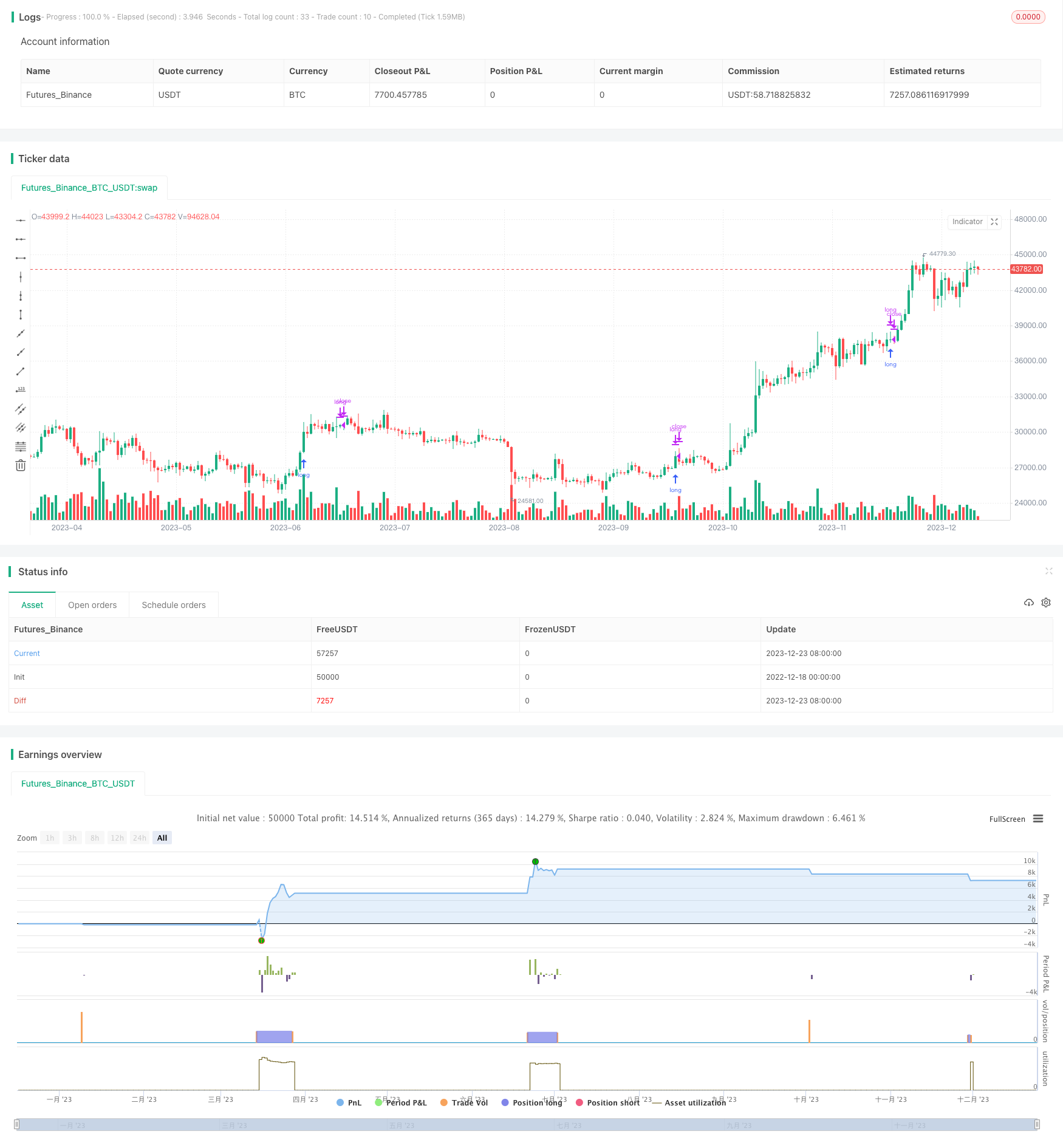
概述
这是一个只做多头的量化交易策略,它结合了枢轴点反转策略和最小二乘移动平均线策略的优点。该策略在牛市中跟随主要趋势进入场内,在观察到枢轴点上轨形成之后判断反转信号做多;同时,它要求收盘价高于最小二乘移动平均线才会开仓做多,使策略更加稳定。
策略原理
该策略融合了枢轴点反转策略和最小二乘移动平均线策略。枢轴点反转策略会计算过去一定交易日的最高价和最低价,得到上轨和下轨。当价格突破上轨时,判断为反转信号。最小二乘移动平均线是一种趋势判断指标,它能更好地逼近价格。该策略在枢轴点上轨形成时,如果收盘价高于最小二径线,就做多。
具体来说,该策略首先计算过去3根K线的最高价和过去16根K线的最低价,得到枢轴点上轨和下轨。在上轨形成时,开仓做多;当下一次下轨形成时,平仓。同时,它要求收盘价高于20日的最小二乘移动平均才会开仓。
策略优势
结合两种策略的优势,使交易决策更稳定可靠
枢轴点策略能判断反转点,最小二乘移动平均线过滤假突破,减少交易风险
只做多头,符合大部分人的心理预期
策略简单清晰,容易理解与优化
交易频次适中,适合中长线操作
风险分析
无法抓住快速下跌行情的机会
存在一定的延迟,可能错过部分上涨机会
牛熊转换时,会产生较大亏损
解决方法:
适当缩短计算周期,减少延迟
调整移动平均线参数,优化参与度
增加止损策略,降低单笔损失
优化方向
加入多种趋势指标组合,提高判断准确性
增加机器学习模型预测结果,指导决策
结合波动率指标,控制仓位规模
优化参数,提高策略胜率
测试更长时间周期数据,验证稳定性
总结
本策略整合枢轴点反转策略和最小二乘移动平均线策略的优势,在判断趋势反转的同时控制风险,属于稳健型策略。它结构简单,易于理解和测试,非常适合量化交易初学者学习和实践。但该策略只做多,无法利用下跌行情获利,这是其主要局限。通过引入更多指标和机器学习等方法进行优化,可以进一步增强该策略的稳定性和跟踪能力,从而获得更好的绩效。
/*backtest
start: 2022-12-18 00:00:00
end: 2023-12-24 00:00:00
period: 1d
basePeriod: 1h
exchanges: [{"eid":"Futures_Binance","currency":"BTC_USDT"}]
*/
//@version=4
//@author exlux99
strategy(title = "Pivot Reversal Upgraded long only", overlay = true, pyramiding=1,initial_capital = 100, default_qty_type= strategy.percent_of_equity, default_qty_value = 100, calc_on_order_fills=false, slippage=0,commission_type=strategy.commission.percent,commission_value=0.1)
/////////////
//time
fromDay = input(defval = 1, title = "From Day", minval = 1, maxval = 31)
fromMonth = input(defval = 1, title = "From Month", minval = 1, maxval = 12)
fromYear = input(defval = 2010, title = "From Year", minval = 1970)
//monday and session
// To Date Inputs
toDay = input(defval = 31, title = "To Day", minval = 1, maxval = 31)
toMonth = input(defval = 12, title = "To Month", minval = 1, maxval = 12)
toYear = input(defval = 2031, title = "To Year", minval = 1970)
startDate = timestamp(fromYear, fromMonth, fromDay, 00, 00)
finishDate = timestamp(toYear, toMonth, toDay, 00, 00)
time_cond = true
//
length = input(title="Length MA", type=input.integer, defval=20)
offset = 0//input(title="Offset", type=input.integer, defval=0)
src = input(close, title="Source")
lsma = linreg(src, length, offset)
//LSMA
leftBars = input(3)
rightBars = input(16)
swh = pivothigh(leftBars, rightBars)
swl = pivotlow(leftBars, rightBars)
swh_cond = not na(swh)
hprice = 0.0
hprice := swh_cond ? swh : hprice[1]
le = false
le := swh_cond and time_cond? true : (le[1] and high > hprice ? false : le[1])
//leverage
multiplier=input(1.0, step=0.5)
g(v, p) => round(v * (pow(10, p))) / pow(10, p)
risk = input(100)
leverage = input(1.0, step = 0.5)
c = g((strategy.equity * leverage / open) * (risk / 100), 4)
//entry
strategy.entry("long", strategy.long,c, when=le and close > lsma, comment="long", stop=(hprice + syminfo.mintick) * multiplier)
swl_cond = not na(swl)
lprice = 0.0
lprice := swl_cond ? swl : lprice[1]
se = false
se := swl_cond ? true : (se[1] and low < lprice ? false : se[1])
strategy.close("long", when=se)